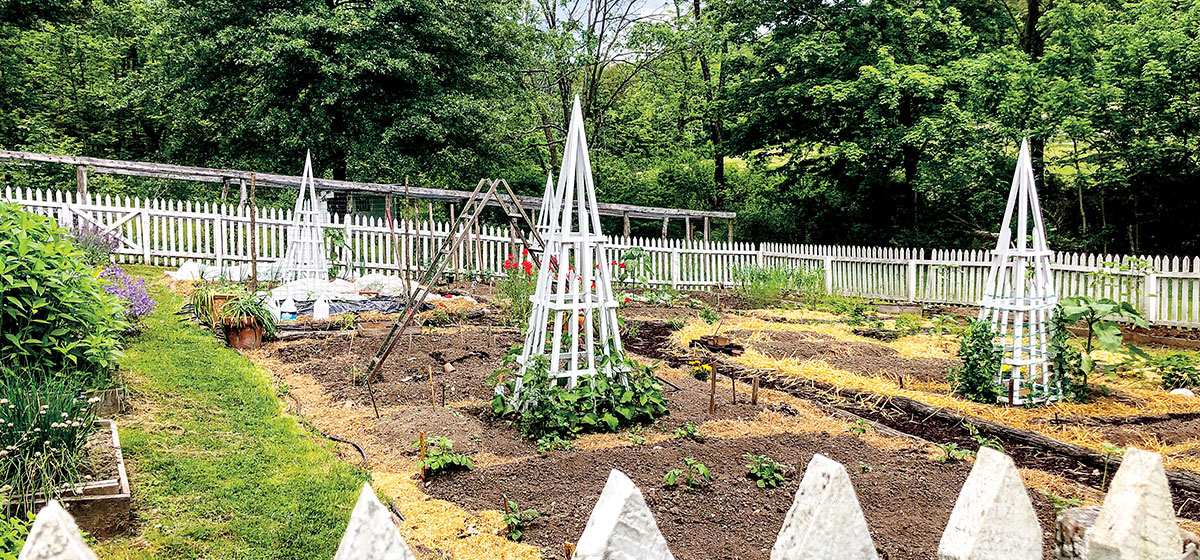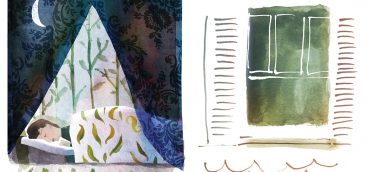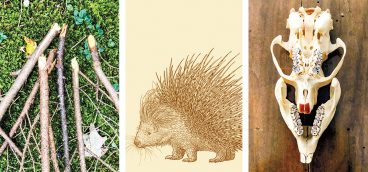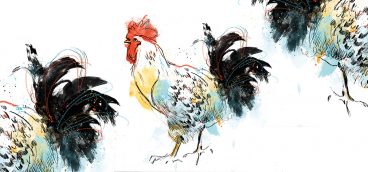My Vegetable Garden, in Springtime

“The Glory of the Garden it abideth not in words.” —Rudyard Kipling
My favorite time in the vegetable garden is in spring, after the soil is tilled and before the seeds are planted. Perennials are poking up—chervil, lovage, sorrel—but otherwise there’s little growth, just a blank canvas. The weather is cool, less humid and with fewer bugs, and it is a joy to dig in the dirt after a long winter. I love to feel the soil between my fingers, the sun on my face, and as I survey the dark earth in geometric rows, the scene is orderly and full of promise, or, as Samuel Johnson said, “the triumph of hope over experience.”
I imagine rows of cabbage uneaten by white moths. Eggplant without aphids. Tomatoes with no blight. Cucumbers without beetles. Broccoli with no worms. Raspberry canes artfully wound around wire, and strawberries tucked in with straw. Enough rain and no nibbling creatures—just plants thriving without chemicals, all beautifully designed.
The bones of my garden, inspired long ago by a visit to Williamsburg, Va., consist of four, locust-lined quadrants, joined in the center by a stone circle of orange, red and white poppies. In the middle of each quadrant is a white tuteur where I train morning glories, runner beans, and sweet peas. Above the quadrants are eight raised beds, and above that, a long row of raspberries. Below are asparagus and strawberry beds, and below that still, three beds for melons and pumpkins so vines can meander through the white pickets. Mulched paths, dotted with pots of agapanthus, dahlias, and Fraises des Bois, run throughout.
But each spring within that basic pattern, I redesign, which is, for me, one of life’s great pleasures. Which rows should be horizontal? Vertical? Where shall I place this year’s cucumber trellis? Should I plant celery in a circle as my book advises? I contemplate crop rotation and companion planting, and choose which volunteers to keep and where—borage, sunflowers, hollyhock, pansies and nicotiana—for as much as I like order, I adore the whimsy of volunteers.
I decide where to plant zinnias, nasturtium, cosmos and other flowers to attract bees, and amend the soil with horse and chicken manure, compost, wood ash, and coffee grounds my husband kindly brings me by the bagful. I take out the green cloches and row covers to protect tender new plants, wade through mud, and tackle the mountain of chickweed I should have eradicated last fall. Occasionally, though, I stop and raise my head. I stand still for a moment, look around at the fluorescent green of the budding trees, and listen for the sweet sound of returning songbirds.
I have tended a western Pennsylvania garden for 32 years. At first, I did everything wrong, hardly knew the habit of a Jerusalem artichoke from a turnip. I ordered so many packets of arugula that the seed company called and asked if I were a business. I thought I needed to plant the entire garden on Memorial Day weekend—our first frost-free date—so I planted from dawn until dusk for three days. I didn’t understand that cold-hardy vegetables such as spinach and radishes could be started as soon as the ground can be worked; peas, some say, on St. Patrick’s Day. I did not know what our babysitter told me—that the last snowfall of the year is called “onion snow,” which is when onions should be planted. I knew nothing of succession planting, nor did I realize garlic was ideally planted the autumn before. And yet that first year was the only year, despite repeated attempts, that I grew small, round, orange-fleshed Charentais melons, as sweet and delectable as I imagine they are in France.
My lofty dreams begin to take shape in winter, long before the first buds of spring, as I ponder seed catalogues by the fire. Maybe this year, I think, I will try rutabaga, speckled trout-back lettuce, snapdragons or cardoons. The great British gardener and poet Vita Sackville West, whose Sissinghurst Castle Garden draws 200,000 visitors a year, must have studied catalogues similarly, as she wrote in her poem, “Winter”:
“The gardener sees what he will never see // Here, in his lamp-lit parable, he’ll scan / Catalogues bright with colour and with hope / Dearest delusions of creative mind.”
When my seeds arrive, I separate them into categories such as brassicas, herbs or root vegetables. I plant them under grow lights in the barn, in wooden or peat trays with wooden markers. I’m a purist here, avoiding plastic as best I can, aesthetics almost as important to me as seed growth. But then reality seeps in. Bugs come out of nowhere, mice shimmy up my seed-starting stand. I water too much, or too little. I speak to the tender seedlings, occasionally even caress the leaves, but hard as I try to nurture them, some just wither and die.
Those that survive must get their true leaves, so while I wait, I get prepared. I line up in alphabetical order last year’s plant markers, rewriting in black the words that faded in sun and rain. I gather up binder twine from hay bales to use as string, and, with help, jury-rig rotting trellises and raised beds so they will last yet another year. I walk in the woods and collect sticks to use as row markers. I love to recycle and reuse.
But in gardening, as in life, there is always room for improvement, and over the years I’ve grown to recognize my many gardening shortfalls. For one, I’m perhaps too thrifty, reusing pots and potting soil when I should use new. I am heavy-handed when transplanting seedlings, vowing each year to be more delicate. I am impatient, wishing plants to harden off faster than necessary, and I can be greedy, planting seedlings too close together as if that will produce more when the opposite is true. And by some trick of nature, if I plant five squash seeds to thin to two, as the packet instructs, the two strongest always end up right next to each other, revealing another serious flaw of mine: I hate to thin. Never can I justify plucking heartlessly out of the soil a perfectly healthy plant that has worked equally as hard to germinate and grow. Lettuce thinnings I eat, of course, but the same cannot be said of a zucchini plant. I always feel guilty.
I am so bothered by the question of thinning that I consult an expert. Do plants feel pain? I ask Simon Gilroy, professor of botany at the University of Wisconsin, whose lab specializes in how plants respond to environmental cues, such as thinning. “Yes, they do sense that they are being wounded and start up anti-herbivore defenses,” he said, “but that is a very different thing from something like our feeling of pain, which is both sensation and emotion layered on each other… I think you are completely right to appreciate plants for the amazing pieces of biology that they are but I would not lose sleep over your gardening.”
Nevertheless, I try to give the thinned plants away.
Years ago, when I lived in New York City, I escaped to my parents’ house in Connecticut, where my mother and I gardened together. “Dirt Therapy,” we called it, but we hardly invented the concept of gardening as healing. “I came to love my rows, my beans… they attached me to the earth, and so I got strength, like Antaeus,” wrote Henry David Thoreau in “Walden.” Gardening as therapy has long been well documented: time slows down, we meditate, imagine and create. Scents calm us, such as that from flowers, but so does wet earth, an aroma called “geosmin,” according to psychiatrist Sue Stuart-Smith in her book, “The Well-Gardened Mind.” She writes: “Green exercise, as it is often called, is more effective at lowering stress levels and improving mood and self-esteem than going to the gym.” Penelope Lively, a British novelist, agrees that gardening is good for us, that we “set spinning our circadian rhythms, jack up our immune systems, and possibly live a few years longer,” but in the end, health benefits are irrelevant. “It is simply a matter of intense engagement with cutting back, taking out, putting in, with this rose, that weed, these seeds, bulbs, tubers,” she writes in “Life in the Garden.” “As an occupation it seems to me unparalleled; productive, beneficial, enjoyable. What more could you want?”
And so, as Voltaire instructed in his novel, Candide, “we must cultivate our garden,” I will be out in the dirt doing it all again this spring. I will rejoice in the hoeing, weeding, raking, thinning! I will train pea vines, stake tomatoes, hill potatoes, blanch celery, and mulch between rows with The New York Times and straw. My seedlings will be transplanted as delicately as I can muster, with all the hope in the world, and I will see what my gardening realm brings in 2021, dearest delusions of my creative mind





